Report on Managing Financial Resources and Decisions for a Business
VerifiedAdded on 2020/01/23
|16
|4451
|425
Report
AI Summary
This report delves into the critical aspects of managing financial resources and making informed financial decisions for a business. It begins by identifying various sources of finance, including internal and external options like venture investors and bank loans, and analyzes their implications. The report evaluates different financial sources, comparing their costs and benefits, and emphasizes the importance of financial planning for effective capital allocation and project selection. It explores the information needed for sound financial decision-making, examines the impact of finance on financial statements (balance sheet, income statement, and statement of retained earnings), and assesses the viability of a project through unit cost calculations. The report also covers major financial statements, their comparison across different business organizations, and the interpretation of financial statements using appropriate tools. The content is designed to provide a comprehensive understanding of financial management principles and their practical application in a business context.
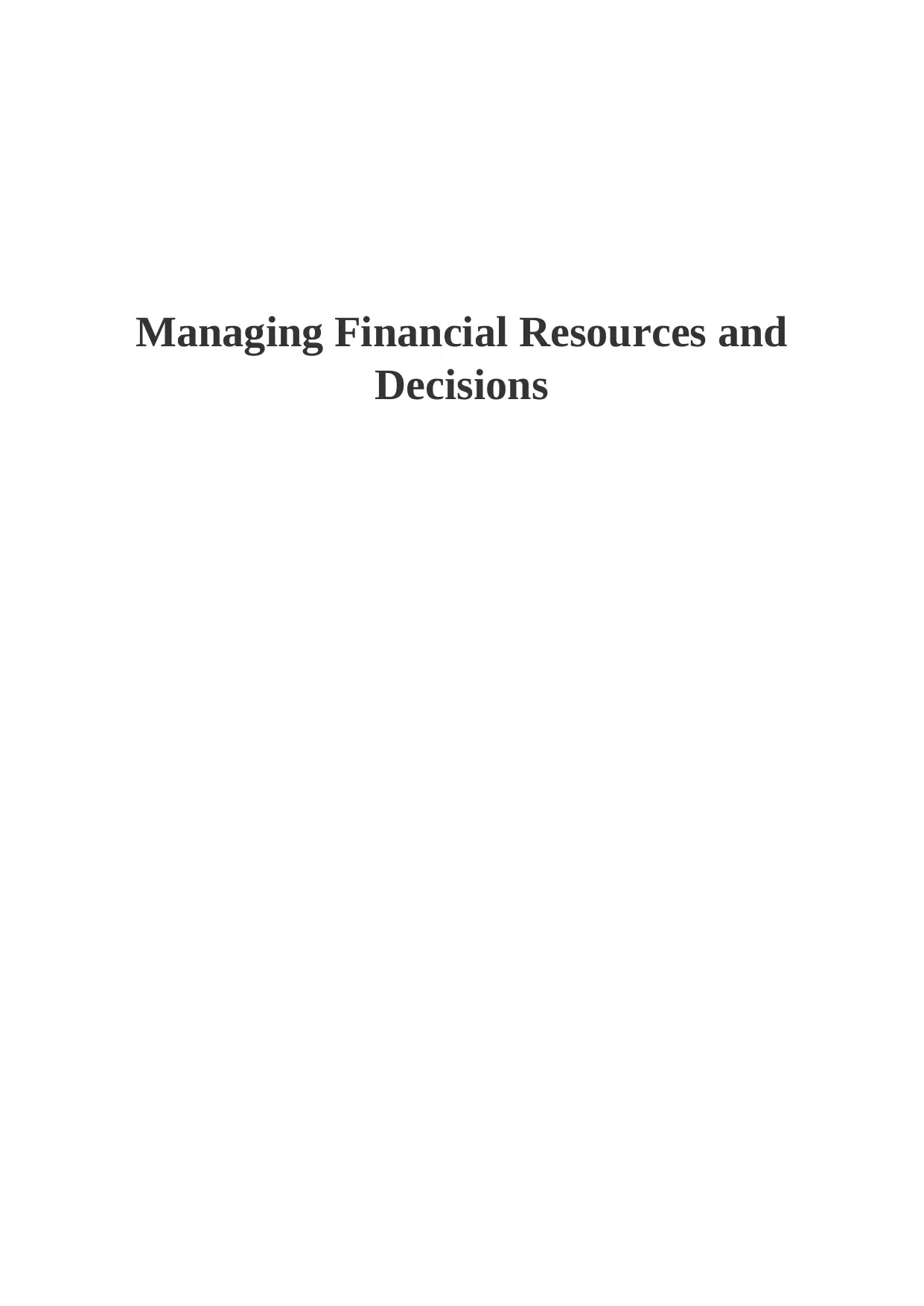
Managing Financial Resources and
Decisions
Decisions
Secure Best Marks with AI Grader
Need help grading? Try our AI Grader for instant feedback on your assignments.
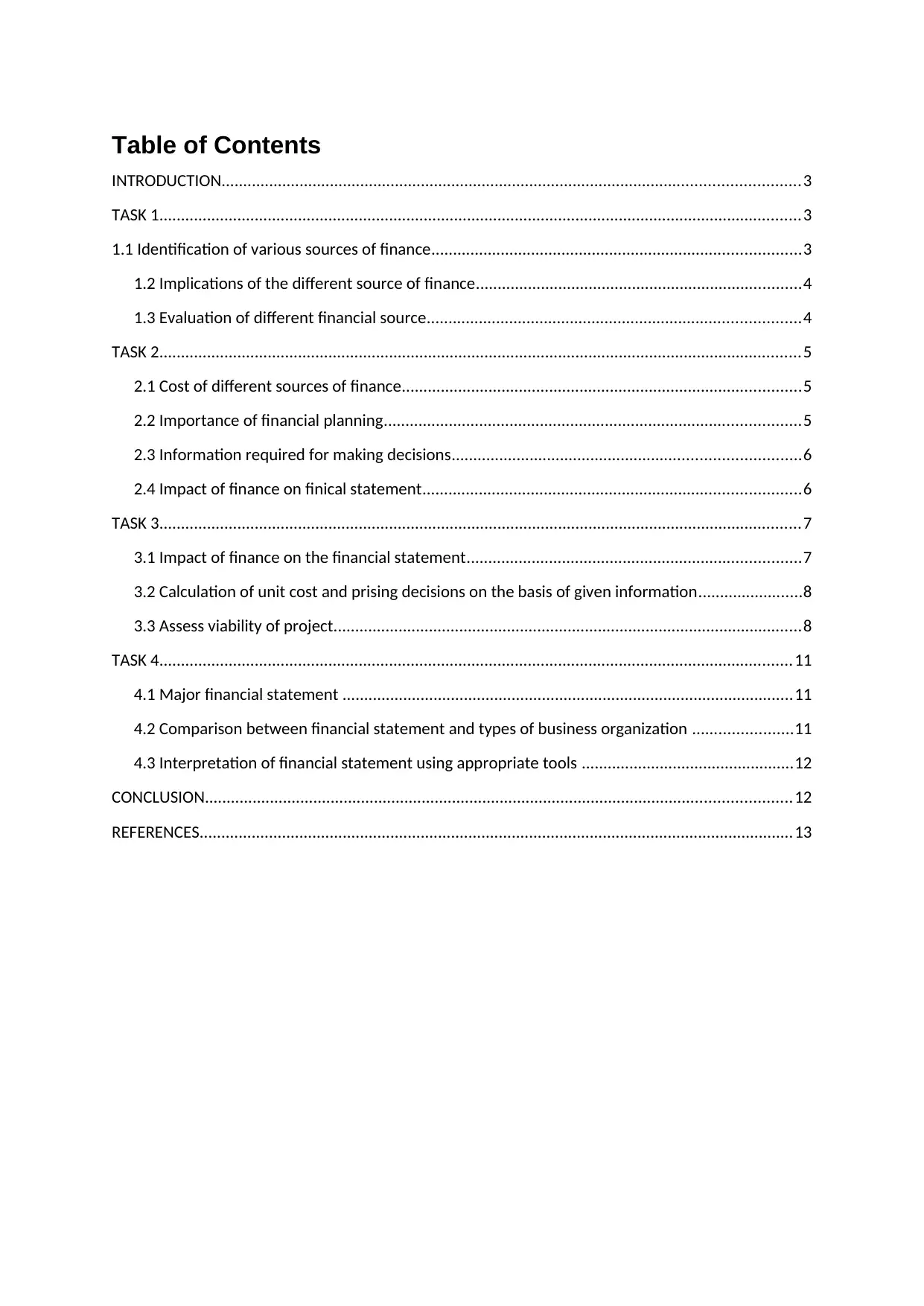
Table of Contents
INTRODUCTION.....................................................................................................................................3
TASK 1....................................................................................................................................................3
1.1 Identification of various sources of finance.....................................................................................3
1.2 Implications of the different source of finance...........................................................................4
1.3 Evaluation of different financial source......................................................................................4
TASK 2....................................................................................................................................................5
2.1 Cost of different sources of finance............................................................................................5
2.2 Importance of financial planning................................................................................................5
2.3 Information required for making decisions................................................................................6
2.4 Impact of finance on finical statement.......................................................................................6
TASK 3....................................................................................................................................................7
3.1 Impact of finance on the financial statement.............................................................................7
3.2 Calculation of unit cost and prising decisions on the basis of given information........................8
3.3 Assess viability of project............................................................................................................8
TASK 4..................................................................................................................................................11
4.1 Major financial statement ........................................................................................................11
4.2 Comparison between financial statement and types of business organization .......................11
4.3 Interpretation of financial statement using appropriate tools .................................................12
CONCLUSION.......................................................................................................................................12
REFERENCES.........................................................................................................................................13
INTRODUCTION.....................................................................................................................................3
TASK 1....................................................................................................................................................3
1.1 Identification of various sources of finance.....................................................................................3
1.2 Implications of the different source of finance...........................................................................4
1.3 Evaluation of different financial source......................................................................................4
TASK 2....................................................................................................................................................5
2.1 Cost of different sources of finance............................................................................................5
2.2 Importance of financial planning................................................................................................5
2.3 Information required for making decisions................................................................................6
2.4 Impact of finance on finical statement.......................................................................................6
TASK 3....................................................................................................................................................7
3.1 Impact of finance on the financial statement.............................................................................7
3.2 Calculation of unit cost and prising decisions on the basis of given information........................8
3.3 Assess viability of project............................................................................................................8
TASK 4..................................................................................................................................................11
4.1 Major financial statement ........................................................................................................11
4.2 Comparison between financial statement and types of business organization .......................11
4.3 Interpretation of financial statement using appropriate tools .................................................12
CONCLUSION.......................................................................................................................................12
REFERENCES.........................................................................................................................................13
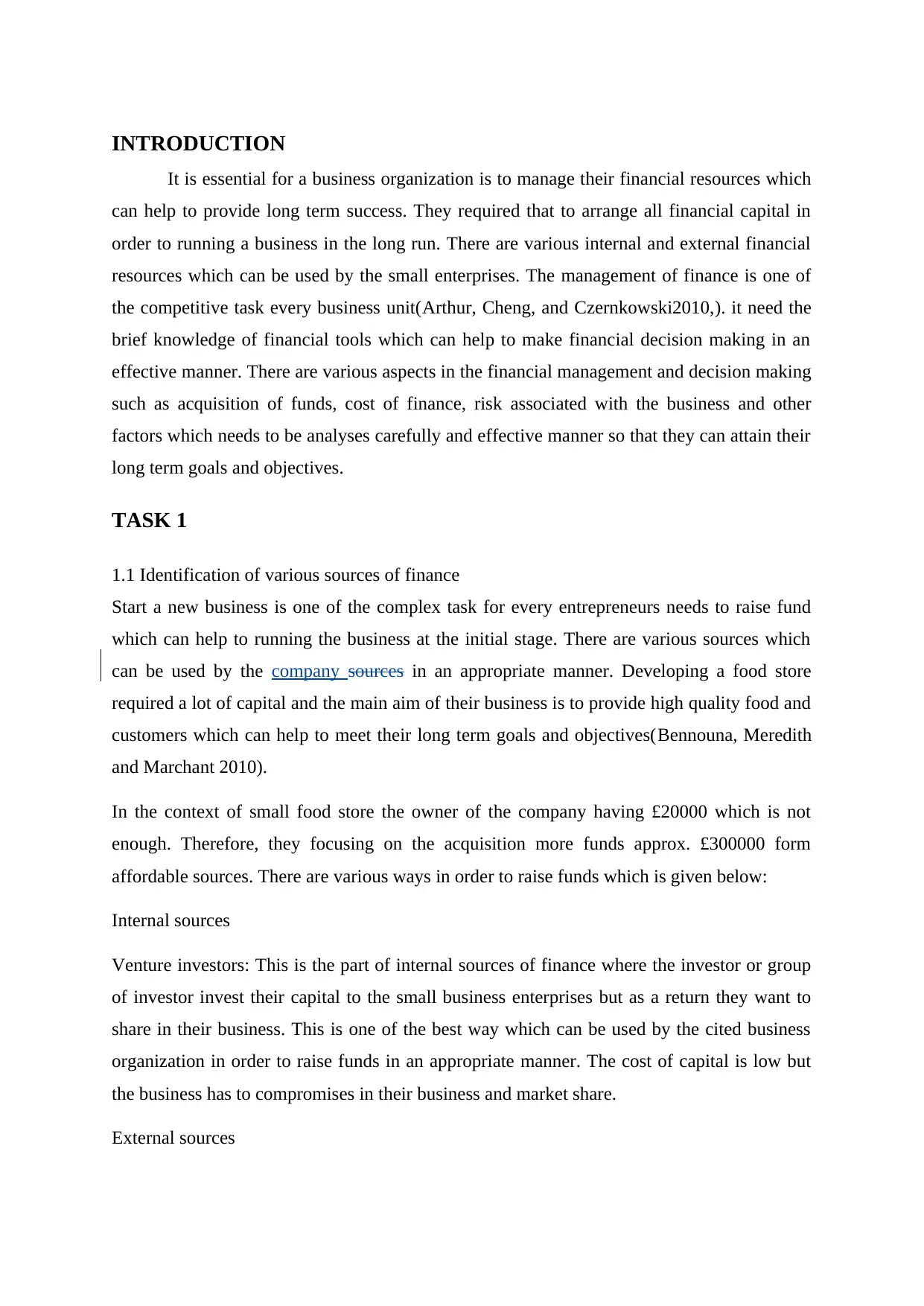
INTRODUCTION
It is essential for a business organization is to manage their financial resources which
can help to provide long term success. They required that to arrange all financial capital in
order to running a business in the long run. There are various internal and external financial
resources which can be used by the small enterprises. The management of finance is one of
the competitive task every business unit(Arthur, Cheng, and Czernkowski2010,). it need the
brief knowledge of financial tools which can help to make financial decision making in an
effective manner. There are various aspects in the financial management and decision making
such as acquisition of funds, cost of finance, risk associated with the business and other
factors which needs to be analyses carefully and effective manner so that they can attain their
long term goals and objectives.
TASK 1
1.1 Identification of various sources of finance
Start a new business is one of the complex task for every entrepreneurs needs to raise fund
which can help to running the business at the initial stage. There are various sources which
can be used by the company sources in an appropriate manner. Developing a food store
required a lot of capital and the main aim of their business is to provide high quality food and
customers which can help to meet their long term goals and objectives(Bennouna, Meredith
and Marchant 2010).
In the context of small food store the owner of the company having £20000 which is not
enough. Therefore, they focusing on the acquisition more funds approx. £300000 form
affordable sources. There are various ways in order to raise funds which is given below:
Internal sources
Venture investors: This is the part of internal sources of finance where the investor or group
of investor invest their capital to the small business enterprises but as a return they want to
share in their business. This is one of the best way which can be used by the cited business
organization in order to raise funds in an appropriate manner. The cost of capital is low but
the business has to compromises in their business and market share.
External sources
It is essential for a business organization is to manage their financial resources which
can help to provide long term success. They required that to arrange all financial capital in
order to running a business in the long run. There are various internal and external financial
resources which can be used by the small enterprises. The management of finance is one of
the competitive task every business unit(Arthur, Cheng, and Czernkowski2010,). it need the
brief knowledge of financial tools which can help to make financial decision making in an
effective manner. There are various aspects in the financial management and decision making
such as acquisition of funds, cost of finance, risk associated with the business and other
factors which needs to be analyses carefully and effective manner so that they can attain their
long term goals and objectives.
TASK 1
1.1 Identification of various sources of finance
Start a new business is one of the complex task for every entrepreneurs needs to raise fund
which can help to running the business at the initial stage. There are various sources which
can be used by the company sources in an appropriate manner. Developing a food store
required a lot of capital and the main aim of their business is to provide high quality food and
customers which can help to meet their long term goals and objectives(Bennouna, Meredith
and Marchant 2010).
In the context of small food store the owner of the company having £20000 which is not
enough. Therefore, they focusing on the acquisition more funds approx. £300000 form
affordable sources. There are various ways in order to raise funds which is given below:
Internal sources
Venture investors: This is the part of internal sources of finance where the investor or group
of investor invest their capital to the small business enterprises but as a return they want to
share in their business. This is one of the best way which can be used by the cited business
organization in order to raise funds in an appropriate manner. The cost of capital is low but
the business has to compromises in their business and market share.
External sources
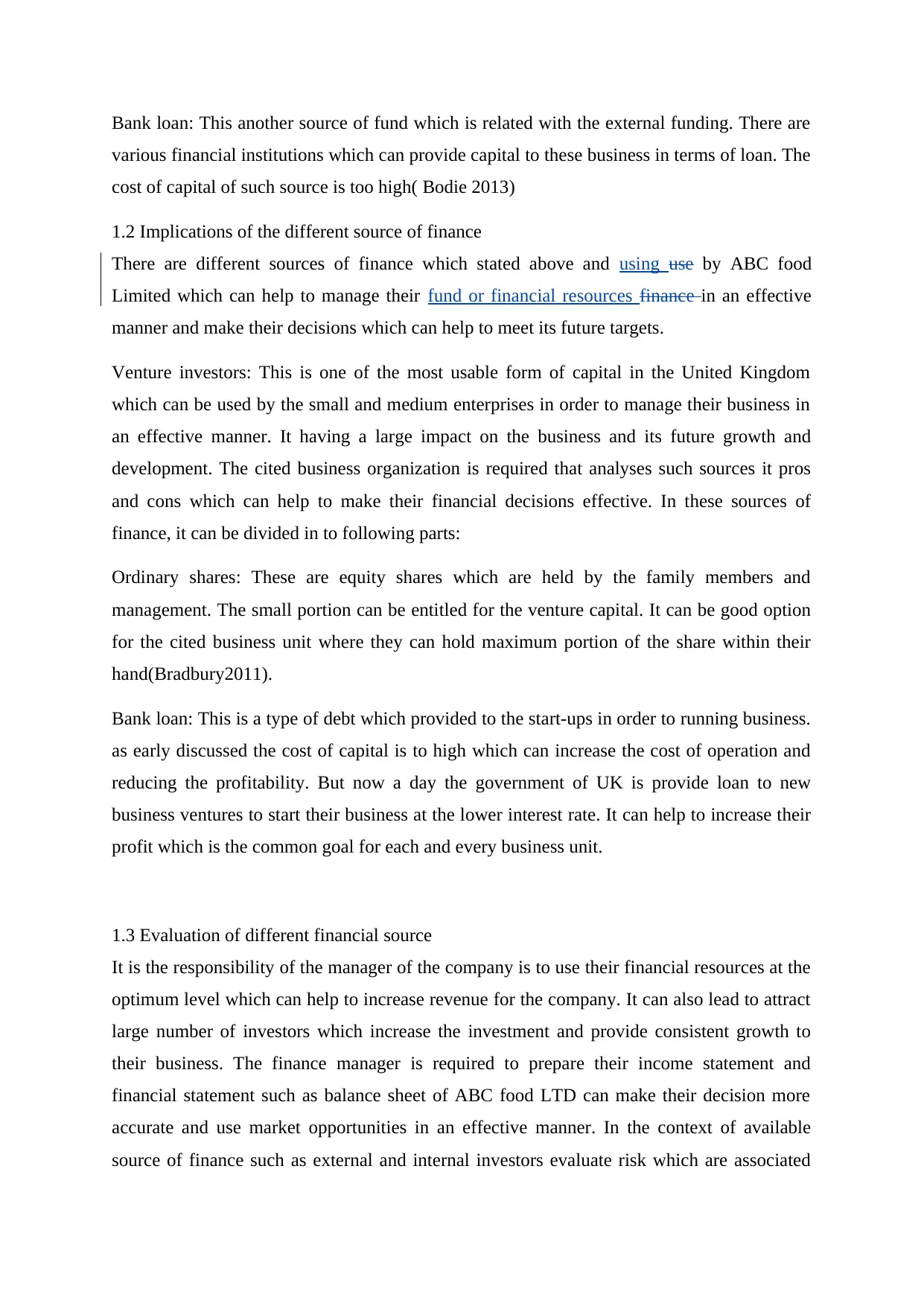
Bank loan: This another source of fund which is related with the external funding. There are
various financial institutions which can provide capital to these business in terms of loan. The
cost of capital of such source is too high( Bodie 2013)
1.2 Implications of the different source of finance
There are different sources of finance which stated above and using use by ABC food
Limited which can help to manage their fund or financial resources finance in an effective
manner and make their decisions which can help to meet its future targets.
Venture investors: This is one of the most usable form of capital in the United Kingdom
which can be used by the small and medium enterprises in order to manage their business in
an effective manner. It having a large impact on the business and its future growth and
development. The cited business organization is required that analyses such sources it pros
and cons which can help to make their financial decisions effective. In these sources of
finance, it can be divided in to following parts:
Ordinary shares: These are equity shares which are held by the family members and
management. The small portion can be entitled for the venture capital. It can be good option
for the cited business unit where they can hold maximum portion of the share within their
hand(Bradbury2011).
Bank loan: This is a type of debt which provided to the start-ups in order to running business.
as early discussed the cost of capital is to high which can increase the cost of operation and
reducing the profitability. But now a day the government of UK is provide loan to new
business ventures to start their business at the lower interest rate. It can help to increase their
profit which is the common goal for each and every business unit.
1.3 Evaluation of different financial source
It is the responsibility of the manager of the company is to use their financial resources at the
optimum level which can help to increase revenue for the company. It can also lead to attract
large number of investors which increase the investment and provide consistent growth to
their business. The finance manager is required to prepare their income statement and
financial statement such as balance sheet of ABC food LTD can make their decision more
accurate and use market opportunities in an effective manner. In the context of available
source of finance such as external and internal investors evaluate risk which are associated
various financial institutions which can provide capital to these business in terms of loan. The
cost of capital of such source is too high( Bodie 2013)
1.2 Implications of the different source of finance
There are different sources of finance which stated above and using use by ABC food
Limited which can help to manage their fund or financial resources finance in an effective
manner and make their decisions which can help to meet its future targets.
Venture investors: This is one of the most usable form of capital in the United Kingdom
which can be used by the small and medium enterprises in order to manage their business in
an effective manner. It having a large impact on the business and its future growth and
development. The cited business organization is required that analyses such sources it pros
and cons which can help to make their financial decisions effective. In these sources of
finance, it can be divided in to following parts:
Ordinary shares: These are equity shares which are held by the family members and
management. The small portion can be entitled for the venture capital. It can be good option
for the cited business unit where they can hold maximum portion of the share within their
hand(Bradbury2011).
Bank loan: This is a type of debt which provided to the start-ups in order to running business.
as early discussed the cost of capital is to high which can increase the cost of operation and
reducing the profitability. But now a day the government of UK is provide loan to new
business ventures to start their business at the lower interest rate. It can help to increase their
profit which is the common goal for each and every business unit.
1.3 Evaluation of different financial source
It is the responsibility of the manager of the company is to use their financial resources at the
optimum level which can help to increase revenue for the company. It can also lead to attract
large number of investors which increase the investment and provide consistent growth to
their business. The finance manager is required to prepare their income statement and
financial statement such as balance sheet of ABC food LTD can make their decision more
accurate and use market opportunities in an effective manner. In the context of available
source of finance such as external and internal investors evaluate risk which are associated
Secure Best Marks with AI Grader
Need help grading? Try our AI Grader for instant feedback on your assignments.
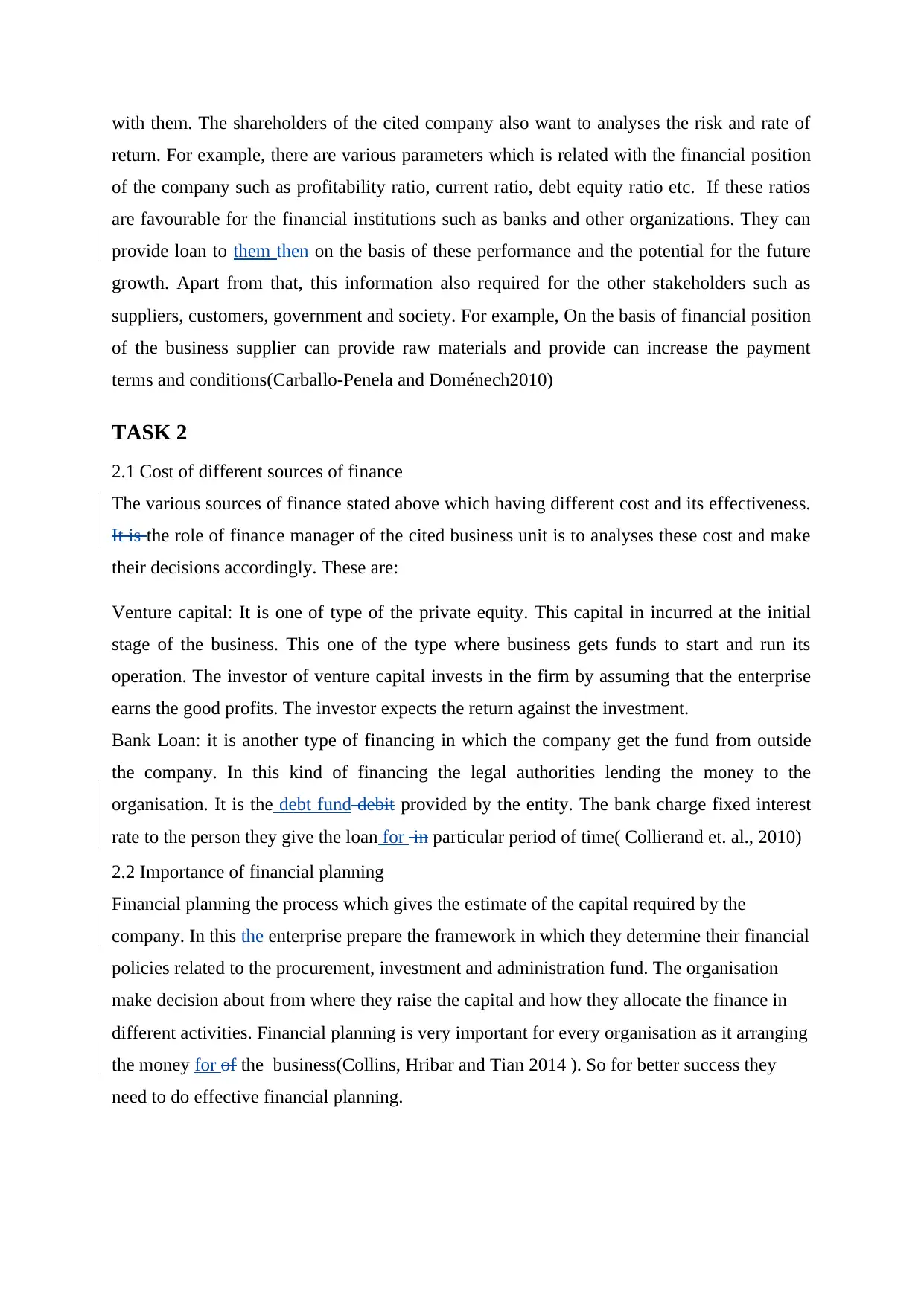
with them. The shareholders of the cited company also want to analyses the risk and rate of
return. For example, there are various parameters which is related with the financial position
of the company such as profitability ratio, current ratio, debt equity ratio etc. If these ratios
are favourable for the financial institutions such as banks and other organizations. They can
provide loan to them then on the basis of these performance and the potential for the future
growth. Apart from that, this information also required for the other stakeholders such as
suppliers, customers, government and society. For example, On the basis of financial position
of the business supplier can provide raw materials and provide can increase the payment
terms and conditions(Carballo-Penela and Doménech2010)
TASK 2
2.1 Cost of different sources of finance
The various sources of finance stated above which having different cost and its effectiveness.
It is the role of finance manager of the cited business unit is to analyses these cost and make
their decisions accordingly. These are:
Venture capital: It is one of type of the private equity. This capital in incurred at the initial
stage of the business. This one of the type where business gets funds to start and run its
operation. The investor of venture capital invests in the firm by assuming that the enterprise
earns the good profits. The investor expects the return against the investment.
Bank Loan: it is another type of financing in which the company get the fund from outside
the company. In this kind of financing the legal authorities lending the money to the
organisation. It is the debt fund debit provided by the entity. The bank charge fixed interest
rate to the person they give the loan for in particular period of time( Collierand et. al., 2010)
2.2 Importance of financial planning
Financial planning the process which gives the estimate of the capital required by the
company. In this the enterprise prepare the framework in which they determine their financial
policies related to the procurement, investment and administration fund. The organisation
make decision about from where they raise the capital and how they allocate the finance in
different activities. Financial planning is very important for every organisation as it arranging
the money for of the business(Collins, Hribar and Tian 2014 ). So for better success they
need to do effective financial planning.
return. For example, there are various parameters which is related with the financial position
of the company such as profitability ratio, current ratio, debt equity ratio etc. If these ratios
are favourable for the financial institutions such as banks and other organizations. They can
provide loan to them then on the basis of these performance and the potential for the future
growth. Apart from that, this information also required for the other stakeholders such as
suppliers, customers, government and society. For example, On the basis of financial position
of the business supplier can provide raw materials and provide can increase the payment
terms and conditions(Carballo-Penela and Doménech2010)
TASK 2
2.1 Cost of different sources of finance
The various sources of finance stated above which having different cost and its effectiveness.
It is the role of finance manager of the cited business unit is to analyses these cost and make
their decisions accordingly. These are:
Venture capital: It is one of type of the private equity. This capital in incurred at the initial
stage of the business. This one of the type where business gets funds to start and run its
operation. The investor of venture capital invests in the firm by assuming that the enterprise
earns the good profits. The investor expects the return against the investment.
Bank Loan: it is another type of financing in which the company get the fund from outside
the company. In this kind of financing the legal authorities lending the money to the
organisation. It is the debt fund debit provided by the entity. The bank charge fixed interest
rate to the person they give the loan for in particular period of time( Collierand et. al., 2010)
2.2 Importance of financial planning
Financial planning the process which gives the estimate of the capital required by the
company. In this the enterprise prepare the framework in which they determine their financial
policies related to the procurement, investment and administration fund. The organisation
make decision about from where they raise the capital and how they allocate the finance in
different activities. Financial planning is very important for every organisation as it arranging
the money for of the business(Collins, Hribar and Tian 2014 ). So for better success they
need to do effective financial planning.
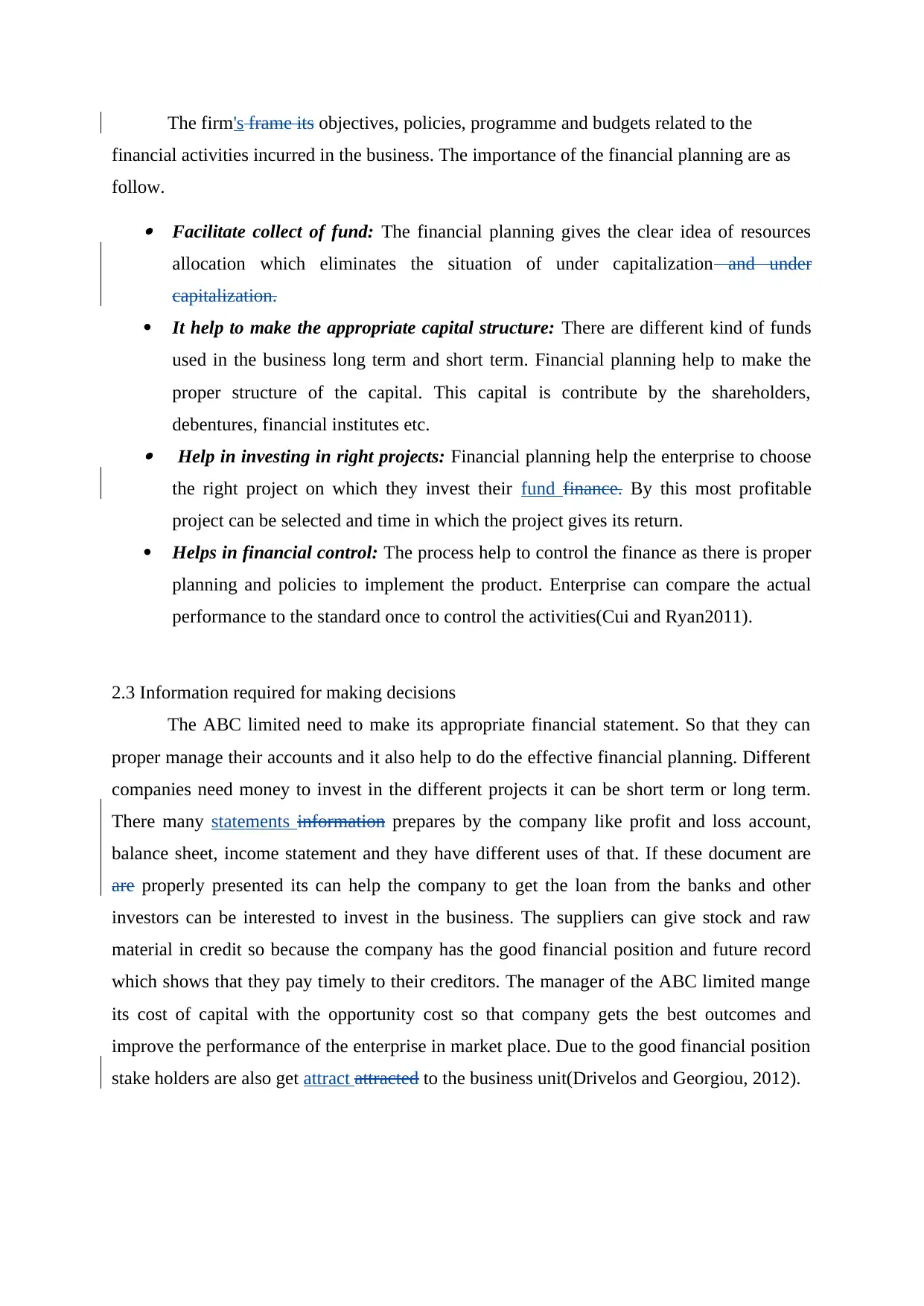
The firm's frame its objectives, policies, programme and budgets related to the
financial activities incurred in the business. The importance of the financial planning are as
follow. Facilitate collect of fund: The financial planning gives the clear idea of resources
allocation which eliminates the situation of under capitalization and under
capitalization.
It help to make the appropriate capital structure: There are different kind of funds
used in the business long term and short term. Financial planning help to make the
proper structure of the capital. This capital is contribute by the shareholders,
debentures, financial institutes etc. Help in investing in right projects: Financial planning help the enterprise to choose
the right project on which they invest their fund finance. By this most profitable
project can be selected and time in which the project gives its return.
Helps in financial control: The process help to control the finance as there is proper
planning and policies to implement the product. Enterprise can compare the actual
performance to the standard once to control the activities(Cui and Ryan2011).
2.3 Information required for making decisions
The ABC limited need to make its appropriate financial statement. So that they can
proper manage their accounts and it also help to do the effective financial planning. Different
companies need money to invest in the different projects it can be short term or long term.
There many statements information prepares by the company like profit and loss account,
balance sheet, income statement and they have different uses of that. If these document are
are properly presented its can help the company to get the loan from the banks and other
investors can be interested to invest in the business. The suppliers can give stock and raw
material in credit so because the company has the good financial position and future record
which shows that they pay timely to their creditors. The manager of the ABC limited mange
its cost of capital with the opportunity cost so that company gets the best outcomes and
improve the performance of the enterprise in market place. Due to the good financial position
stake holders are also get attract attracted to the business unit(Drivelos and Georgiou, 2012).
financial activities incurred in the business. The importance of the financial planning are as
follow. Facilitate collect of fund: The financial planning gives the clear idea of resources
allocation which eliminates the situation of under capitalization and under
capitalization.
It help to make the appropriate capital structure: There are different kind of funds
used in the business long term and short term. Financial planning help to make the
proper structure of the capital. This capital is contribute by the shareholders,
debentures, financial institutes etc. Help in investing in right projects: Financial planning help the enterprise to choose
the right project on which they invest their fund finance. By this most profitable
project can be selected and time in which the project gives its return.
Helps in financial control: The process help to control the finance as there is proper
planning and policies to implement the product. Enterprise can compare the actual
performance to the standard once to control the activities(Cui and Ryan2011).
2.3 Information required for making decisions
The ABC limited need to make its appropriate financial statement. So that they can
proper manage their accounts and it also help to do the effective financial planning. Different
companies need money to invest in the different projects it can be short term or long term.
There many statements information prepares by the company like profit and loss account,
balance sheet, income statement and they have different uses of that. If these document are
are properly presented its can help the company to get the loan from the banks and other
investors can be interested to invest in the business. The suppliers can give stock and raw
material in credit so because the company has the good financial position and future record
which shows that they pay timely to their creditors. The manager of the ABC limited mange
its cost of capital with the opportunity cost so that company gets the best outcomes and
improve the performance of the enterprise in market place. Due to the good financial position
stake holders are also get attract attracted to the business unit(Drivelos and Georgiou, 2012).
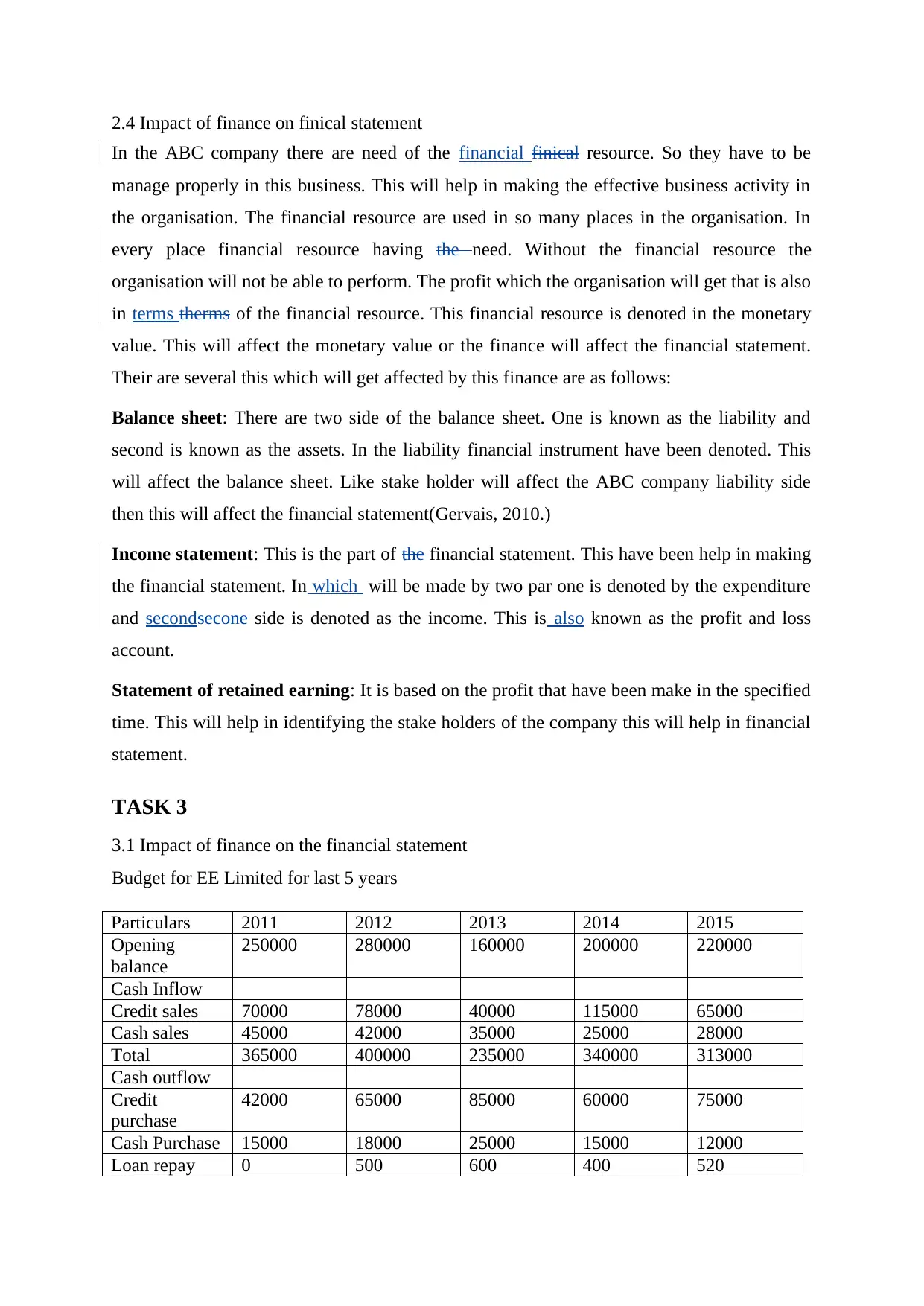
2.4 Impact of finance on finical statement
In the ABC company there are need of the financial finical resource. So they have to be
manage properly in this business. This will help in making the effective business activity in
the organisation. The financial resource are used in so many places in the organisation. In
every place financial resource having the need. Without the financial resource the
organisation will not be able to perform. The profit which the organisation will get that is also
in terms therms of the financial resource. This financial resource is denoted in the monetary
value. This will affect the monetary value or the finance will affect the financial statement.
Their are several this which will get affected by this finance are as follows:
Balance sheet: There are two side of the balance sheet. One is known as the liability and
second is known as the assets. In the liability financial instrument have been denoted. This
will affect the balance sheet. Like stake holder will affect the ABC company liability side
then this will affect the financial statement(Gervais, 2010.)
Income statement: This is the part of the financial statement. This have been help in making
the financial statement. In which will be made by two par one is denoted by the expenditure
and secondsecone side is denoted as the income. This is also known as the profit and loss
account.
Statement of retained earning: It is based on the profit that have been make in the specified
time. This will help in identifying the stake holders of the company this will help in financial
statement.
TASK 3
3.1 Impact of finance on the financial statement
Budget for EE Limited for last 5 years
Particulars 2011 2012 2013 2014 2015
Opening
balance
250000 280000 160000 200000 220000
Cash Inflow
Credit sales 70000 78000 40000 115000 65000
Cash sales 45000 42000 35000 25000 28000
Total 365000 400000 235000 340000 313000
Cash outflow
Credit
purchase
42000 65000 85000 60000 75000
Cash Purchase 15000 18000 25000 15000 12000
Loan repay 0 500 600 400 520
In the ABC company there are need of the financial finical resource. So they have to be
manage properly in this business. This will help in making the effective business activity in
the organisation. The financial resource are used in so many places in the organisation. In
every place financial resource having the need. Without the financial resource the
organisation will not be able to perform. The profit which the organisation will get that is also
in terms therms of the financial resource. This financial resource is denoted in the monetary
value. This will affect the monetary value or the finance will affect the financial statement.
Their are several this which will get affected by this finance are as follows:
Balance sheet: There are two side of the balance sheet. One is known as the liability and
second is known as the assets. In the liability financial instrument have been denoted. This
will affect the balance sheet. Like stake holder will affect the ABC company liability side
then this will affect the financial statement(Gervais, 2010.)
Income statement: This is the part of the financial statement. This have been help in making
the financial statement. In which will be made by two par one is denoted by the expenditure
and secondsecone side is denoted as the income. This is also known as the profit and loss
account.
Statement of retained earning: It is based on the profit that have been make in the specified
time. This will help in identifying the stake holders of the company this will help in financial
statement.
TASK 3
3.1 Impact of finance on the financial statement
Budget for EE Limited for last 5 years
Particulars 2011 2012 2013 2014 2015
Opening
balance
250000 280000 160000 200000 220000
Cash Inflow
Credit sales 70000 78000 40000 115000 65000
Cash sales 45000 42000 35000 25000 28000
Total 365000 400000 235000 340000 313000
Cash outflow
Credit
purchase
42000 65000 85000 60000 75000
Cash Purchase 15000 18000 25000 15000 12000
Loan repay 0 500 600 400 520
Paraphrase This Document
Need a fresh take? Get an instant paraphrase of this document with our AI Paraphraser
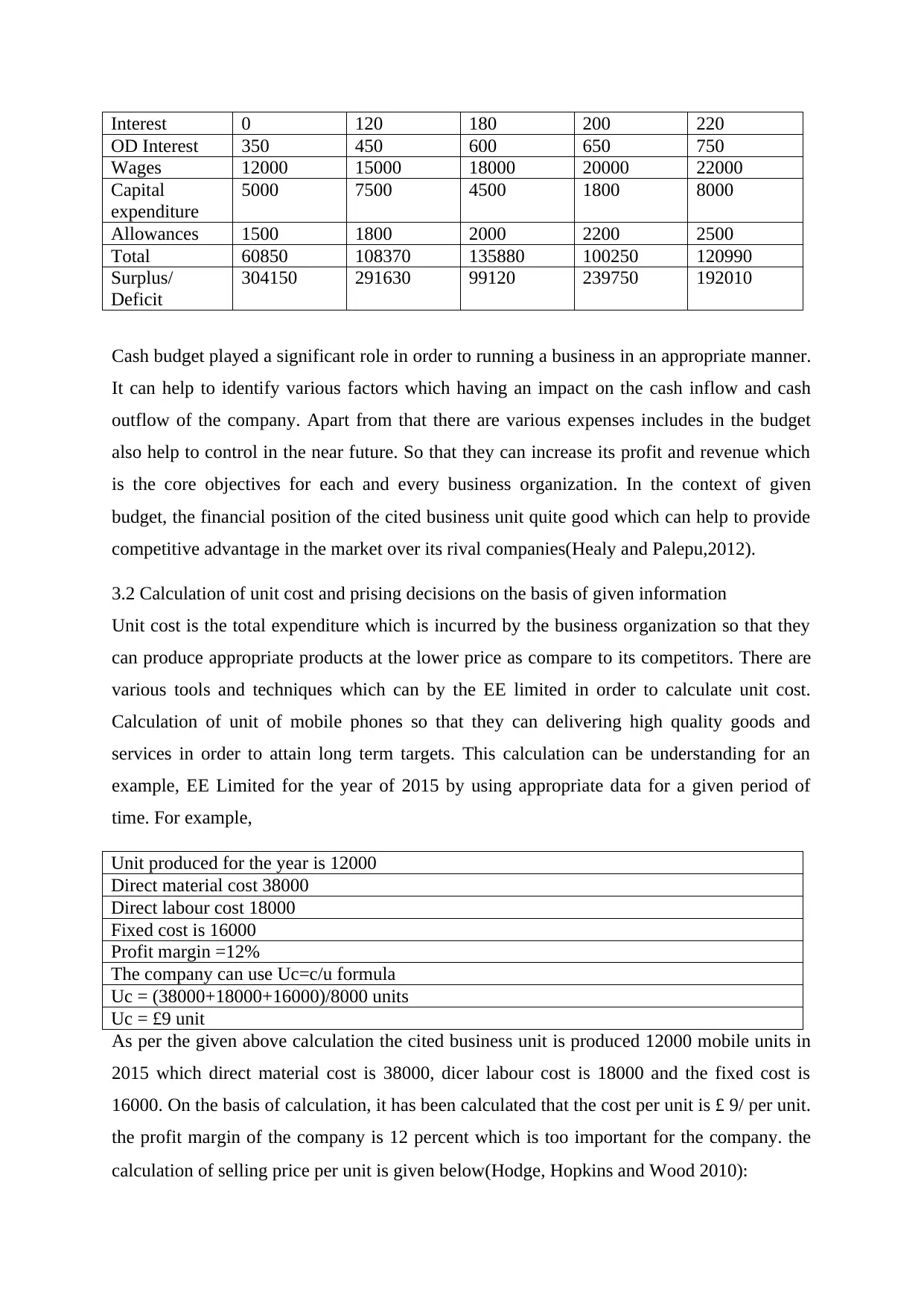
Interest 0 120 180 200 220
OD Interest 350 450 600 650 750
Wages 12000 15000 18000 20000 22000
Capital
expenditure
5000 7500 4500 1800 8000
Allowances 1500 1800 2000 2200 2500
Total 60850 108370 135880 100250 120990
Surplus/
Deficit
304150 291630 99120 239750 192010
Cash budget played a significant role in order to running a business in an appropriate manner.
It can help to identify various factors which having an impact on the cash inflow and cash
outflow of the company. Apart from that there are various expenses includes in the budget
also help to control in the near future. So that they can increase its profit and revenue which
is the core objectives for each and every business organization. In the context of given
budget, the financial position of the cited business unit quite good which can help to provide
competitive advantage in the market over its rival companies(Healy and Palepu,2012).
3.2 Calculation of unit cost and prising decisions on the basis of given information
Unit cost is the total expenditure which is incurred by the business organization so that they
can produce appropriate products at the lower price as compare to its competitors. There are
various tools and techniques which can by the EE limited in order to calculate unit cost.
Calculation of unit of mobile phones so that they can delivering high quality goods and
services in order to attain long term targets. This calculation can be understanding for an
example, EE Limited for the year of 2015 by using appropriate data for a given period of
time. For example,
Unit produced for the year is 12000
Direct material cost 38000
Direct labour cost 18000
Fixed cost is 16000
Profit margin =12%
The company can use Uc=c/u formula
Uc = (38000+18000+16000)/8000 units
Uc = £9 unit
As per the given above calculation the cited business unit is produced 12000 mobile units in
2015 which direct material cost is 38000, dicer labour cost is 18000 and the fixed cost is
16000. On the basis of calculation, it has been calculated that the cost per unit is £ 9/ per unit.
the profit margin of the company is 12 percent which is too important for the company. the
calculation of selling price per unit is given below(Hodge, Hopkins and Wood 2010):
OD Interest 350 450 600 650 750
Wages 12000 15000 18000 20000 22000
Capital
expenditure
5000 7500 4500 1800 8000
Allowances 1500 1800 2000 2200 2500
Total 60850 108370 135880 100250 120990
Surplus/
Deficit
304150 291630 99120 239750 192010
Cash budget played a significant role in order to running a business in an appropriate manner.
It can help to identify various factors which having an impact on the cash inflow and cash
outflow of the company. Apart from that there are various expenses includes in the budget
also help to control in the near future. So that they can increase its profit and revenue which
is the core objectives for each and every business organization. In the context of given
budget, the financial position of the cited business unit quite good which can help to provide
competitive advantage in the market over its rival companies(Healy and Palepu,2012).
3.2 Calculation of unit cost and prising decisions on the basis of given information
Unit cost is the total expenditure which is incurred by the business organization so that they
can produce appropriate products at the lower price as compare to its competitors. There are
various tools and techniques which can by the EE limited in order to calculate unit cost.
Calculation of unit of mobile phones so that they can delivering high quality goods and
services in order to attain long term targets. This calculation can be understanding for an
example, EE Limited for the year of 2015 by using appropriate data for a given period of
time. For example,
Unit produced for the year is 12000
Direct material cost 38000
Direct labour cost 18000
Fixed cost is 16000
Profit margin =12%
The company can use Uc=c/u formula
Uc = (38000+18000+16000)/8000 units
Uc = £9 unit
As per the given above calculation the cited business unit is produced 12000 mobile units in
2015 which direct material cost is 38000, dicer labour cost is 18000 and the fixed cost is
16000. On the basis of calculation, it has been calculated that the cost per unit is £ 9/ per unit.
the profit margin of the company is 12 percent which is too important for the company. the
calculation of selling price per unit is given below(Hodge, Hopkins and Wood 2010):
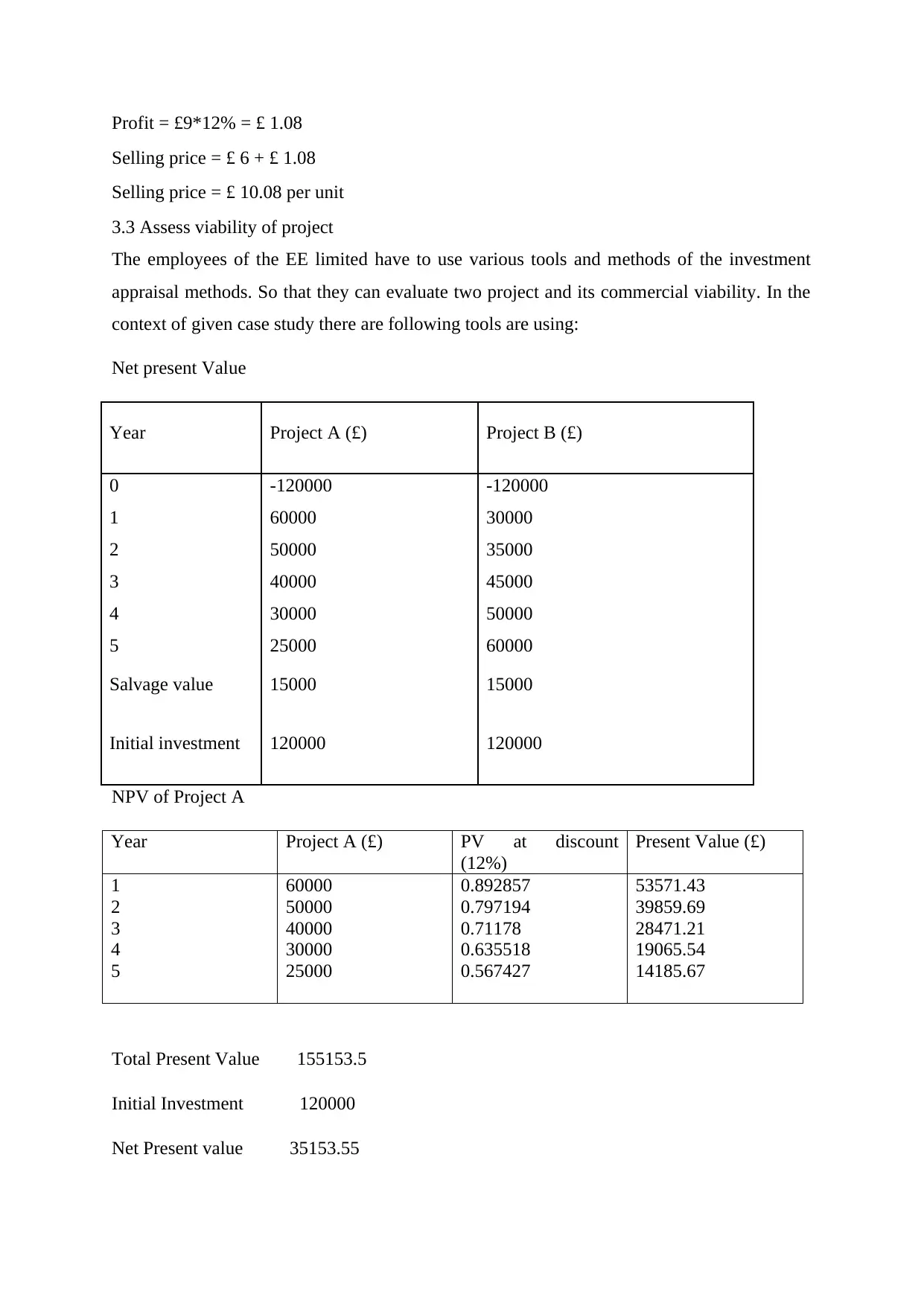
Profit = £9*12% = £ 1.08
Selling price = £ 6 + £ 1.08
Selling price = £ 10.08 per unit
3.3 Assess viability of project
The employees of the EE limited have to use various tools and methods of the investment
appraisal methods. So that they can evaluate two project and its commercial viability. In the
context of given case study there are following tools are using:
Net present Value
Year Project A (£) Project B (£)
0 -120000 -120000
1 60000 30000
2 50000 35000
3 40000 45000
4 30000 50000
5 25000 60000
Salvage value 15000 15000
Initial investment 120000 120000
NPV of Project A
Year Project A (£) PV at discount
(12%)
Present Value (£)
1
2
3
4
5
60000
50000
40000
30000
25000
0.892857
0.797194
0.71178
0.635518
0.567427
53571.43
39859.69
28471.21
19065.54
14185.67
Total Present Value 155153.5
Initial Investment 120000
Net Present value 35153.55
Selling price = £ 6 + £ 1.08
Selling price = £ 10.08 per unit
3.3 Assess viability of project
The employees of the EE limited have to use various tools and methods of the investment
appraisal methods. So that they can evaluate two project and its commercial viability. In the
context of given case study there are following tools are using:
Net present Value
Year Project A (£) Project B (£)
0 -120000 -120000
1 60000 30000
2 50000 35000
3 40000 45000
4 30000 50000
5 25000 60000
Salvage value 15000 15000
Initial investment 120000 120000
NPV of Project A
Year Project A (£) PV at discount
(12%)
Present Value (£)
1
2
3
4
5
60000
50000
40000
30000
25000
0.892857
0.797194
0.71178
0.635518
0.567427
53571.43
39859.69
28471.21
19065.54
14185.67
Total Present Value 155153.5
Initial Investment 120000
Net Present value 35153.55
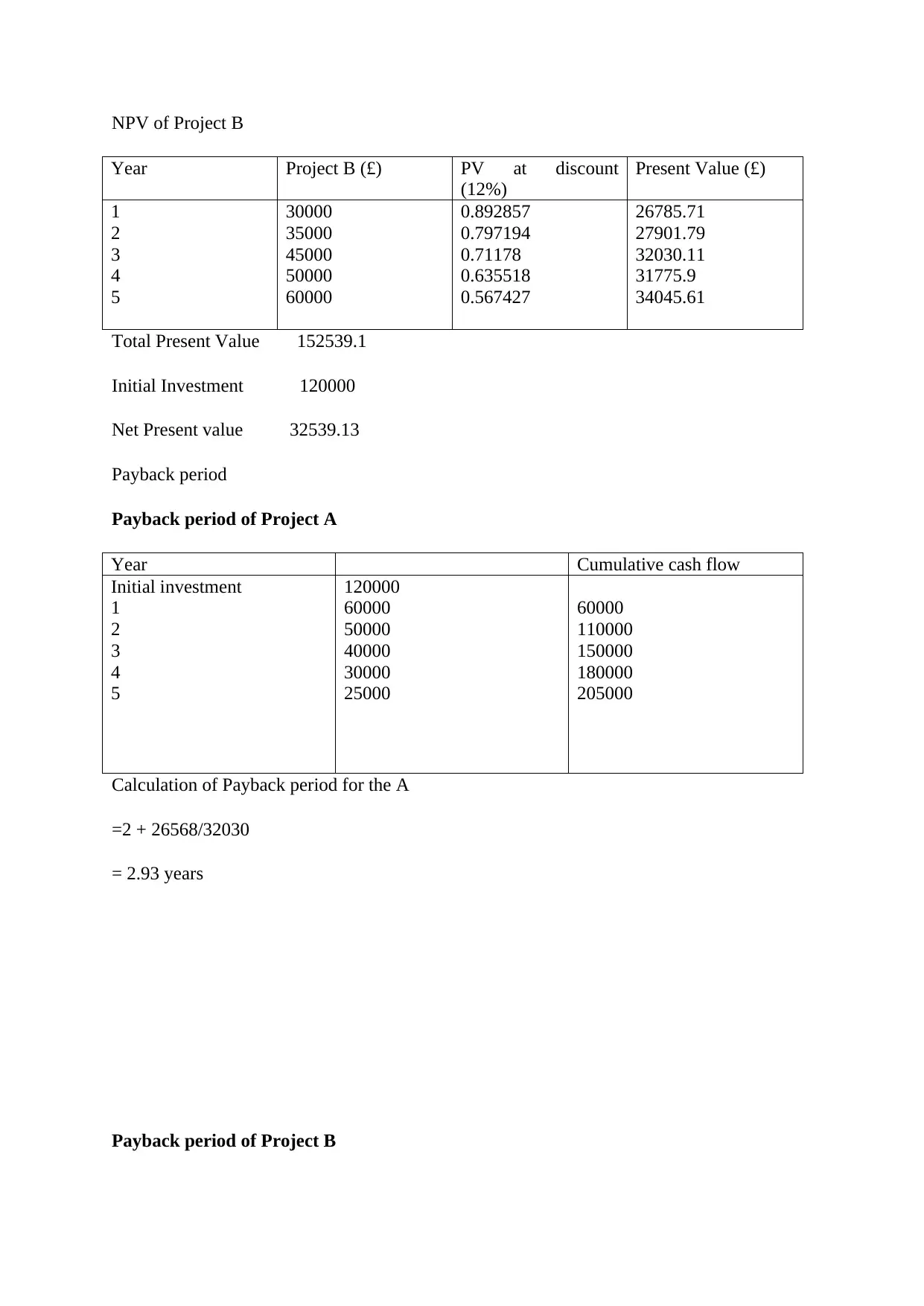
NPV of Project B
Year Project B (£) PV at discount
(12%)
Present Value (£)
1
2
3
4
5
30000
35000
45000
50000
60000
0.892857
0.797194
0.71178
0.635518
0.567427
26785.71
27901.79
32030.11
31775.9
34045.61
Total Present Value 152539.1
Initial Investment 120000
Net Present value 32539.13
Payback period
Payback period of Project A
Year Cumulative cash flow
Initial investment
1
2
3
4
5
120000
60000
50000
40000
30000
25000
60000
110000
150000
180000
205000
Calculation of Payback period for the A
=2 + 26568/32030
= 2.93 years
Payback period of Project B
Year Project B (£) PV at discount
(12%)
Present Value (£)
1
2
3
4
5
30000
35000
45000
50000
60000
0.892857
0.797194
0.71178
0.635518
0.567427
26785.71
27901.79
32030.11
31775.9
34045.61
Total Present Value 152539.1
Initial Investment 120000
Net Present value 32539.13
Payback period
Payback period of Project A
Year Cumulative cash flow
Initial investment
1
2
3
4
5
120000
60000
50000
40000
30000
25000
60000
110000
150000
180000
205000
Calculation of Payback period for the A
=2 + 26568/32030
= 2.93 years
Payback period of Project B
Secure Best Marks with AI Grader
Need help grading? Try our AI Grader for instant feedback on your assignments.
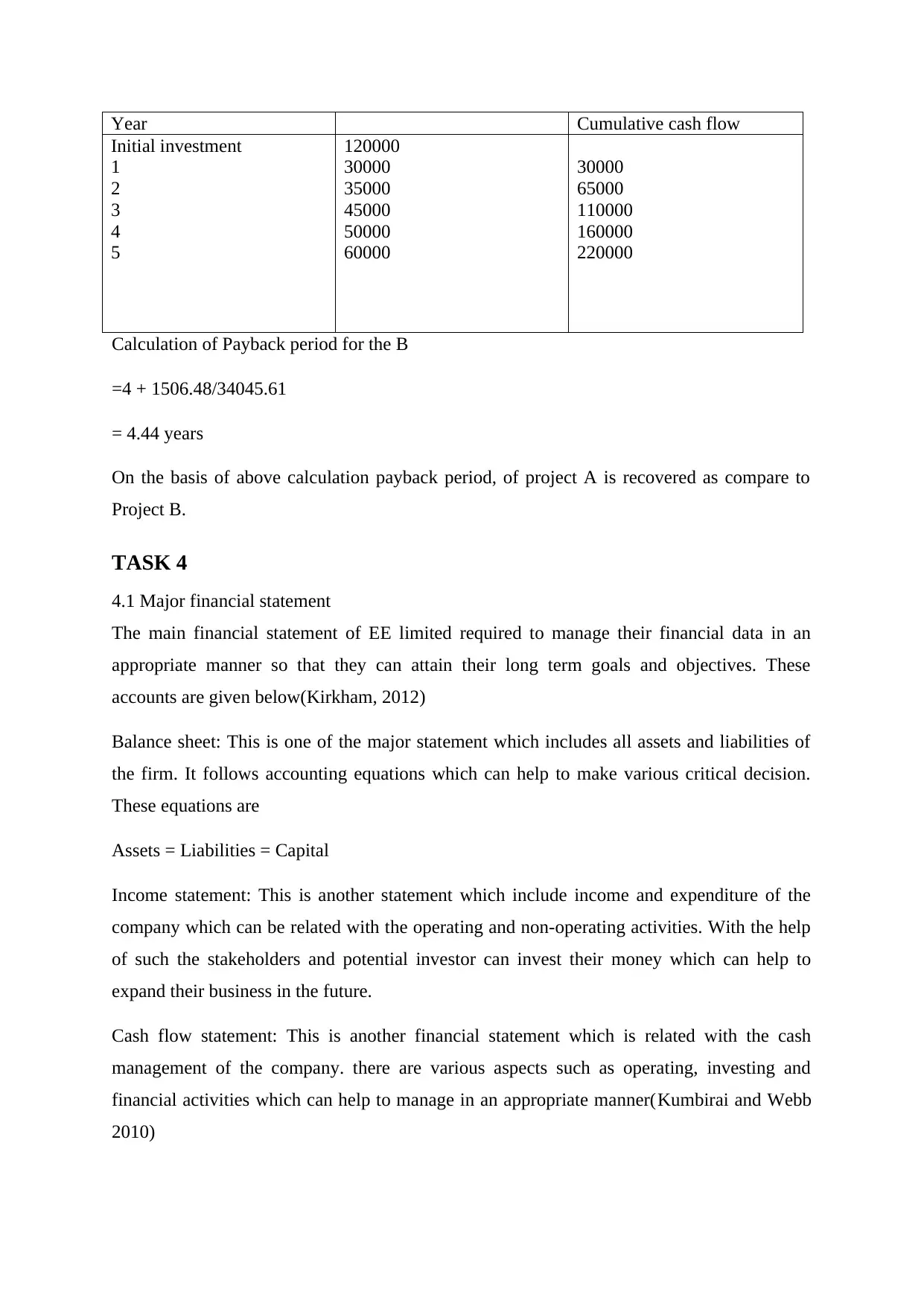
Year Cumulative cash flow
Initial investment
1
2
3
4
5
120000
30000
35000
45000
50000
60000
30000
65000
110000
160000
220000
Calculation of Payback period for the B
=4 + 1506.48/34045.61
= 4.44 years
On the basis of above calculation payback period, of project A is recovered as compare to
Project B.
TASK 4
4.1 Major financial statement
The main financial statement of EE limited required to manage their financial data in an
appropriate manner so that they can attain their long term goals and objectives. These
accounts are given below(Kirkham, 2012)
Balance sheet: This is one of the major statement which includes all assets and liabilities of
the firm. It follows accounting equations which can help to make various critical decision.
These equations are
Assets = Liabilities = Capital
Income statement: This is another statement which include income and expenditure of the
company which can be related with the operating and non-operating activities. With the help
of such the stakeholders and potential investor can invest their money which can help to
expand their business in the future.
Cash flow statement: This is another financial statement which is related with the cash
management of the company. there are various aspects such as operating, investing and
financial activities which can help to manage in an appropriate manner(Kumbirai and Webb
2010)
Initial investment
1
2
3
4
5
120000
30000
35000
45000
50000
60000
30000
65000
110000
160000
220000
Calculation of Payback period for the B
=4 + 1506.48/34045.61
= 4.44 years
On the basis of above calculation payback period, of project A is recovered as compare to
Project B.
TASK 4
4.1 Major financial statement
The main financial statement of EE limited required to manage their financial data in an
appropriate manner so that they can attain their long term goals and objectives. These
accounts are given below(Kirkham, 2012)
Balance sheet: This is one of the major statement which includes all assets and liabilities of
the firm. It follows accounting equations which can help to make various critical decision.
These equations are
Assets = Liabilities = Capital
Income statement: This is another statement which include income and expenditure of the
company which can be related with the operating and non-operating activities. With the help
of such the stakeholders and potential investor can invest their money which can help to
expand their business in the future.
Cash flow statement: This is another financial statement which is related with the cash
management of the company. there are various aspects such as operating, investing and
financial activities which can help to manage in an appropriate manner(Kumbirai and Webb
2010)
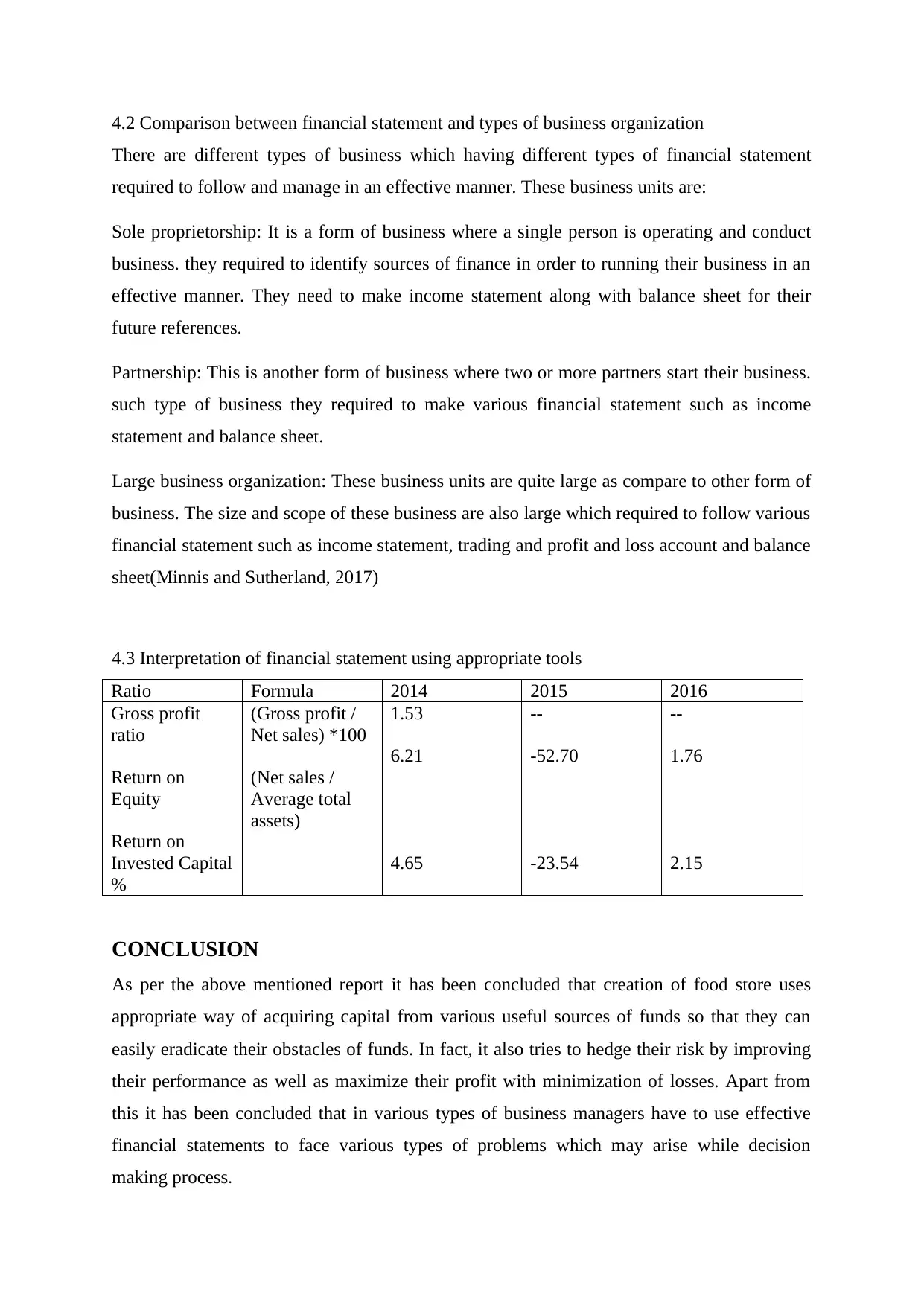
4.2 Comparison between financial statement and types of business organization
There are different types of business which having different types of financial statement
required to follow and manage in an effective manner. These business units are:
Sole proprietorship: It is a form of business where a single person is operating and conduct
business. they required to identify sources of finance in order to running their business in an
effective manner. They need to make income statement along with balance sheet for their
future references.
Partnership: This is another form of business where two or more partners start their business.
such type of business they required to make various financial statement such as income
statement and balance sheet.
Large business organization: These business units are quite large as compare to other form of
business. The size and scope of these business are also large which required to follow various
financial statement such as income statement, trading and profit and loss account and balance
sheet(Minnis and Sutherland, 2017)
4.3 Interpretation of financial statement using appropriate tools
Ratio Formula 2014 2015 2016
Gross profit
ratio
Return on
Equity
Return on
Invested Capital
%
(Gross profit /
Net sales) *100
(Net sales /
Average total
assets)
1.53
6.21
4.65
--
-52.70
-23.54
--
1.76
2.15
CONCLUSION
As per the above mentioned report it has been concluded that creation of food store uses
appropriate way of acquiring capital from various useful sources of funds so that they can
easily eradicate their obstacles of funds. In fact, it also tries to hedge their risk by improving
their performance as well as maximize their profit with minimization of losses. Apart from
this it has been concluded that in various types of business managers have to use effective
financial statements to face various types of problems which may arise while decision
making process.
There are different types of business which having different types of financial statement
required to follow and manage in an effective manner. These business units are:
Sole proprietorship: It is a form of business where a single person is operating and conduct
business. they required to identify sources of finance in order to running their business in an
effective manner. They need to make income statement along with balance sheet for their
future references.
Partnership: This is another form of business where two or more partners start their business.
such type of business they required to make various financial statement such as income
statement and balance sheet.
Large business organization: These business units are quite large as compare to other form of
business. The size and scope of these business are also large which required to follow various
financial statement such as income statement, trading and profit and loss account and balance
sheet(Minnis and Sutherland, 2017)
4.3 Interpretation of financial statement using appropriate tools
Ratio Formula 2014 2015 2016
Gross profit
ratio
Return on
Equity
Return on
Invested Capital
%
(Gross profit /
Net sales) *100
(Net sales /
Average total
assets)
1.53
6.21
4.65
--
-52.70
-23.54
--
1.76
2.15
CONCLUSION
As per the above mentioned report it has been concluded that creation of food store uses
appropriate way of acquiring capital from various useful sources of funds so that they can
easily eradicate their obstacles of funds. In fact, it also tries to hedge their risk by improving
their performance as well as maximize their profit with minimization of losses. Apart from
this it has been concluded that in various types of business managers have to use effective
financial statements to face various types of problems which may arise while decision
making process.

Paraphrase This Document
Need a fresh take? Get an instant paraphrase of this document with our AI Paraphraser
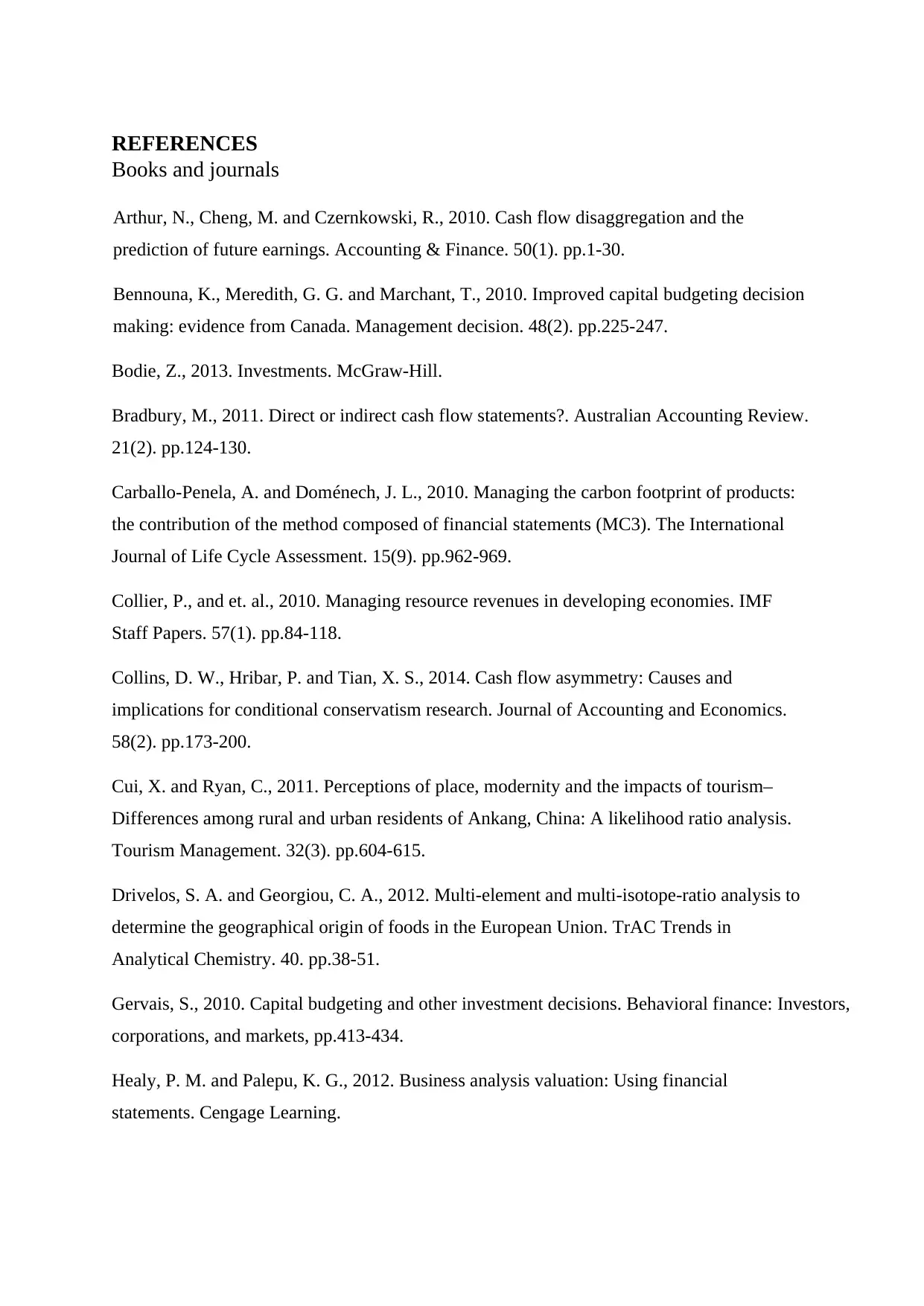
REFERENCES
Books and journals
Arthur, N., Cheng, M. and Czernkowski, R., 2010. Cash flow disaggregation and the
prediction of future earnings. Accounting & Finance. 50(1). pp.1-30.
Bennouna, K., Meredith, G. G. and Marchant, T., 2010. Improved capital budgeting decision
making: evidence from Canada. Management decision. 48(2). pp.225-247.
Bodie, Z., 2013. Investments. McGraw-Hill.
Bradbury, M., 2011. Direct or indirect cash flow statements?. Australian Accounting Review.
21(2). pp.124-130.
Carballo-Penela, A. and Doménech, J. L., 2010. Managing the carbon footprint of products:
the contribution of the method composed of financial statements (MC3). The International
Journal of Life Cycle Assessment. 15(9). pp.962-969.
Collier, P., and et. al., 2010. Managing resource revenues in developing economies. IMF
Staff Papers. 57(1). pp.84-118.
Collins, D. W., Hribar, P. and Tian, X. S., 2014. Cash flow asymmetry: Causes and
implications for conditional conservatism research. Journal of Accounting and Economics.
58(2). pp.173-200.
Cui, X. and Ryan, C., 2011. Perceptions of place, modernity and the impacts of tourism–
Differences among rural and urban residents of Ankang, China: A likelihood ratio analysis.
Tourism Management. 32(3). pp.604-615.
Drivelos, S. A. and Georgiou, C. A., 2012. Multi-element and multi-isotope-ratio analysis to
determine the geographical origin of foods in the European Union. TrAC Trends in
Analytical Chemistry. 40. pp.38-51.
Gervais, S., 2010. Capital budgeting and other investment decisions. Behavioral finance: Investors,
corporations, and markets, pp.413-434.
Healy, P. M. and Palepu, K. G., 2012. Business analysis valuation: Using financial
statements. Cengage Learning.
Books and journals
Arthur, N., Cheng, M. and Czernkowski, R., 2010. Cash flow disaggregation and the
prediction of future earnings. Accounting & Finance. 50(1). pp.1-30.
Bennouna, K., Meredith, G. G. and Marchant, T., 2010. Improved capital budgeting decision
making: evidence from Canada. Management decision. 48(2). pp.225-247.
Bodie, Z., 2013. Investments. McGraw-Hill.
Bradbury, M., 2011. Direct or indirect cash flow statements?. Australian Accounting Review.
21(2). pp.124-130.
Carballo-Penela, A. and Doménech, J. L., 2010. Managing the carbon footprint of products:
the contribution of the method composed of financial statements (MC3). The International
Journal of Life Cycle Assessment. 15(9). pp.962-969.
Collier, P., and et. al., 2010. Managing resource revenues in developing economies. IMF
Staff Papers. 57(1). pp.84-118.
Collins, D. W., Hribar, P. and Tian, X. S., 2014. Cash flow asymmetry: Causes and
implications for conditional conservatism research. Journal of Accounting and Economics.
58(2). pp.173-200.
Cui, X. and Ryan, C., 2011. Perceptions of place, modernity and the impacts of tourism–
Differences among rural and urban residents of Ankang, China: A likelihood ratio analysis.
Tourism Management. 32(3). pp.604-615.
Drivelos, S. A. and Georgiou, C. A., 2012. Multi-element and multi-isotope-ratio analysis to
determine the geographical origin of foods in the European Union. TrAC Trends in
Analytical Chemistry. 40. pp.38-51.
Gervais, S., 2010. Capital budgeting and other investment decisions. Behavioral finance: Investors,
corporations, and markets, pp.413-434.
Healy, P. M. and Palepu, K. G., 2012. Business analysis valuation: Using financial
statements. Cengage Learning.

Hodge, F. D., Hopkins, P. E. and Wood, D. A., 2010. The effects of financial statement
information proximity and feedback on cash flow forecasts. Contemporary Accounting
Research. 27(1). pp.101-133.
Kirkham, R., 2012. Liquidity analysis using cash flow ratios and traditional ratios: The
telecommunications sector in Australia. The Journal of New Business Ideas & Trends. 10(1).
p.1.
Kumbirai, M. and Webb, R., 2010. A financial ratio analysis of commercial bank
performance in South Africa. African Review of Economics and Finance. 2(1). pp.30-53.
Minnis, M. and Sutherland, A., 2017. Financial statements as monitoring mechanisms:
Evidence from small commercial loans. Journal of Accounting Research. 55(1). pp.197-233.
Müller, V. O., 2011. Value relevance of consolidated versus parent company financial
statements: evidence from the largest three European capital markets. Accounting and
Management Information Systems. 10(3). p.326.
Petzke, K. J., Fuller, B. T. and Metges, C. C., 2010. Advances in natural stable isotope ratio
analysis of human hair to determine nutritional and metabolic status. Current Opinion in
Clinical Nutrition & Metabolic Care. 13(5). pp.532-540.
Purce, J., 2014. The impact of corporate strategy on human resource management. New
Perspectives on Human Resource Management (Routledge Revivals). 67.
Rana, M. M., Islam, M. S. and Kouzani, A. Z., 2010, February. Peak to average power ratio
analysis for LTE systems. In Communication Software and Networks, 2010. ICCSN'10.
Second International Conference on (pp. 516-520). IEEE.
Serafeim, G., 2011. Consequences and institutional determinants of unregulated corporate
financial statements: Evidence from embedded value reporting. Journal of accounting
research. 49(2). pp.529-571.
Smith, W. K., 2014. Dynamic decision making: A model of senior leaders managing strategic
paradoxes. Academy of Management Journal. 57(6). pp.1592-1623.
Stent, W., Bradbury, M. and Hooks, J., 2010. IFRS in New Zealand: effects on financial
statements and ratios. Pacific accounting review. 22(2). pp.92-107.
Online
information proximity and feedback on cash flow forecasts. Contemporary Accounting
Research. 27(1). pp.101-133.
Kirkham, R., 2012. Liquidity analysis using cash flow ratios and traditional ratios: The
telecommunications sector in Australia. The Journal of New Business Ideas & Trends. 10(1).
p.1.
Kumbirai, M. and Webb, R., 2010. A financial ratio analysis of commercial bank
performance in South Africa. African Review of Economics and Finance. 2(1). pp.30-53.
Minnis, M. and Sutherland, A., 2017. Financial statements as monitoring mechanisms:
Evidence from small commercial loans. Journal of Accounting Research. 55(1). pp.197-233.
Müller, V. O., 2011. Value relevance of consolidated versus parent company financial
statements: evidence from the largest three European capital markets. Accounting and
Management Information Systems. 10(3). p.326.
Petzke, K. J., Fuller, B. T. and Metges, C. C., 2010. Advances in natural stable isotope ratio
analysis of human hair to determine nutritional and metabolic status. Current Opinion in
Clinical Nutrition & Metabolic Care. 13(5). pp.532-540.
Purce, J., 2014. The impact of corporate strategy on human resource management. New
Perspectives on Human Resource Management (Routledge Revivals). 67.
Rana, M. M., Islam, M. S. and Kouzani, A. Z., 2010, February. Peak to average power ratio
analysis for LTE systems. In Communication Software and Networks, 2010. ICCSN'10.
Second International Conference on (pp. 516-520). IEEE.
Serafeim, G., 2011. Consequences and institutional determinants of unregulated corporate
financial statements: Evidence from embedded value reporting. Journal of accounting
research. 49(2). pp.529-571.
Smith, W. K., 2014. Dynamic decision making: A model of senior leaders managing strategic
paradoxes. Academy of Management Journal. 57(6). pp.1592-1623.
Stent, W., Bradbury, M. and Hooks, J., 2010. IFRS in New Zealand: effects on financial
statements and ratios. Pacific accounting review. 22(2). pp.92-107.
Online
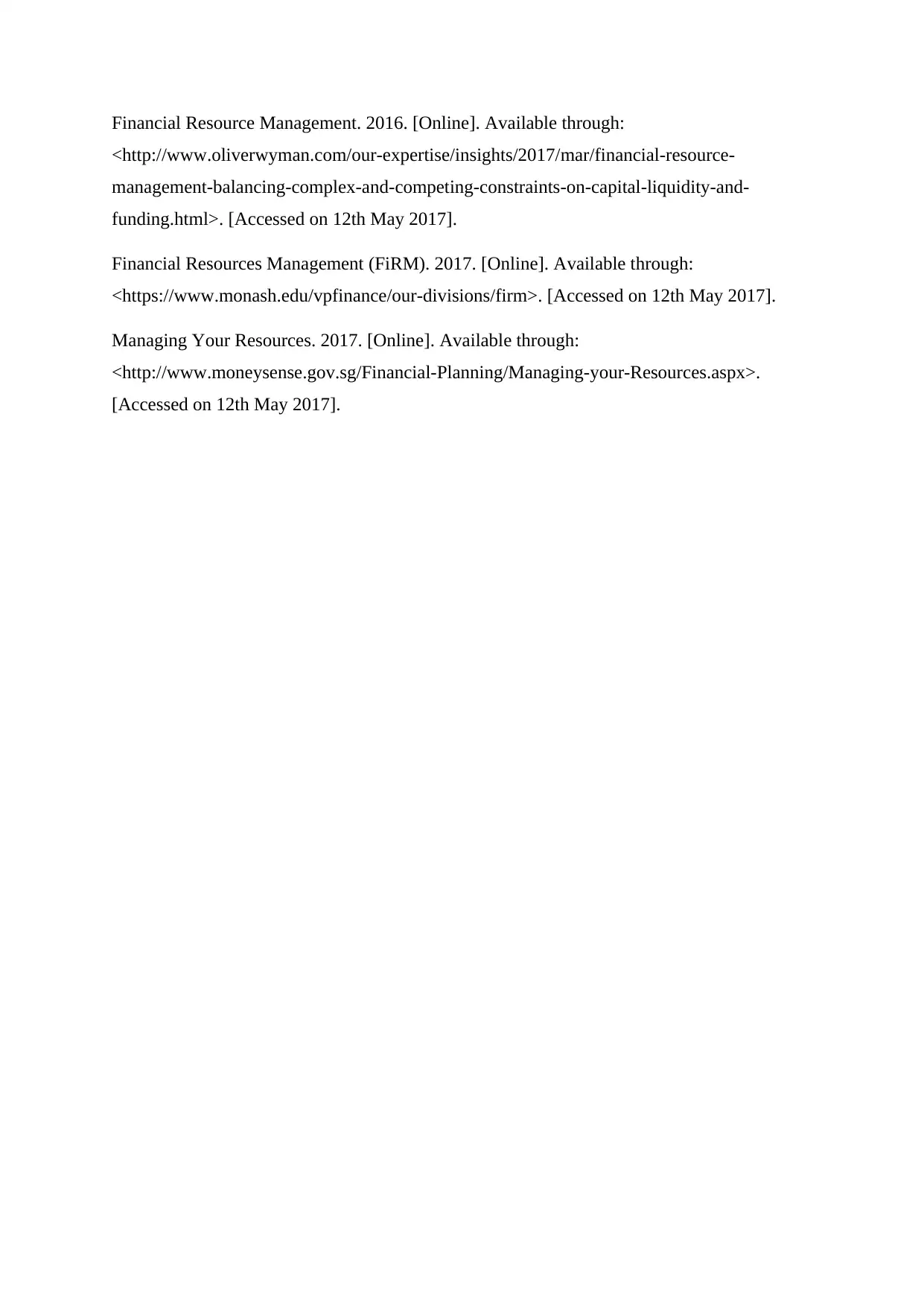
Financial Resource Management. 2016. [Online]. Available through:
<http://www.oliverwyman.com/our-expertise/insights/2017/mar/financial-resource-
management-balancing-complex-and-competing-constraints-on-capital-liquidity-and-
funding.html>. [Accessed on 12th May 2017].
Financial Resources Management (FiRM). 2017. [Online]. Available through:
<https://www.monash.edu/vpfinance/our-divisions/firm>. [Accessed on 12th May 2017].
Managing Your Resources. 2017. [Online]. Available through:
<http://www.moneysense.gov.sg/Financial-Planning/Managing-your-Resources.aspx>.
[Accessed on 12th May 2017].
<http://www.oliverwyman.com/our-expertise/insights/2017/mar/financial-resource-
management-balancing-complex-and-competing-constraints-on-capital-liquidity-and-
funding.html>. [Accessed on 12th May 2017].
Financial Resources Management (FiRM). 2017. [Online]. Available through:
<https://www.monash.edu/vpfinance/our-divisions/firm>. [Accessed on 12th May 2017].
Managing Your Resources. 2017. [Online]. Available through:
<http://www.moneysense.gov.sg/Financial-Planning/Managing-your-Resources.aspx>.
[Accessed on 12th May 2017].
1 out of 16
Related Documents
Your All-in-One AI-Powered Toolkit for Academic Success.
+13062052269
info@desklib.com
Available 24*7 on WhatsApp / Email
![[object Object]](/_next/static/media/star-bottom.7253800d.svg)
Unlock your academic potential
© 2024 | Zucol Services PVT LTD | All rights reserved.





